This post may contain affiliate links. Please read our disclosure policy.
Learn how to make Lebanese baklawa (baklava) with confidence, ease, and joy! Here you will make phyllo your friend, clarified butter your baby, toasty ground nuts your nirvana. And flower water syrup—that sweet simplicity that distinguishes Lebanese baklawa from all other baklavas—your pure, aromatic nectar. Scroll down to find links to all of the info. Let’s go!
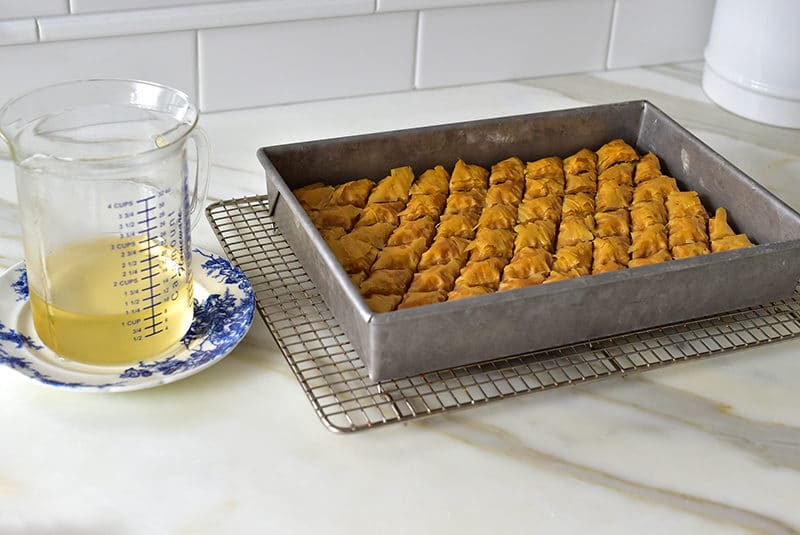
Making baklawa is a little like math, which is an odd thing for me to compare it to since math and I have never been on great terms. But I’ve been witnessing (well, from my perch in the kitchen) some seriously successful math tutoring at our house recently, and I see how it works. When you break it down into its many parts and come to understand each part really well, then the whole becomes a solvable, not-so-scary project.
This is how it is with Lebanese baklawa: there are many parts, and each one has certain nuances that when truly understood, work to make a pastry that is not so mysterious or far-reaching to welcome into your baking repertoire. The final equation, the end result, is so satisfying and wonderful that it is clear why baklawa is the most classic pastry of the Middle East.
Over the years that I’ve been baking baklawa, I’m always learning, keeping notes, trying new ways. Being a baklawa student means that how I did things in the past may not be how I do them today, and how I do it tomorrow may also change. Which in turn means that blog posts, cookbooks, and the like are a snapshot of a point in time sharing what I knew and did then. Some things of course stay the same, and others will change, but always with refinement and improvement as the goals (hi, perfectionists!).
Let’s roll up our sleeves and get to the details of how to make Lebanese baklawa:
What is baklava?
Baklawa (pronounced bahk-LAY-wa or even bit-LAY-wa, and sometimes: bit-LAY-wee) is the Lebanese pastry of phyllo, clarified butter, nuts, and flower water simple syrup. Lebanese baklawa is different in flavor than Greek baklava or some Turkish baklavas. Baklawa is made in a variety of shapes and sizes, but homemade baklawa is typically rolled or layered and cut into diamonds. All of the baklawa bakers I have known prepare the various parts of the pastry in advance, so that on baking day baklawa is mainly an assembly project of phyllo, nuts, cutting, buttering, baking, [smelling the aroma] and drenching in syrup. The end. Oh, and eating.
Watch this as a quick initial overview:
The phyllo dough.
Phyllo is tissue-thin dough that is found in boxes in the frozen dessert section at the grocery store. My favorite brand is Athens, for its flavor and reliable thinness. The look of the Athens box has changed since the photos here were taken. The box is now white, lovely actually. It’s a bonus that my favorite brand is found in most any grocery store that carries phyllo! The key with any brand you buy is thinness, as phyllo is made in varying thicknesses that are numbered. The one you want is #4. Phyllo sheet size typically comes in two options: 9×14 and 14×18. The most readily available, grocery-store size is the smaller 9×14. The large size is often found at specialty food stores and is desirable when you want to make large sheet pans, wedding/funeral/big-stuff baklawa. I use the 9×14 size most often because it fits nearly perfectly into a 9×13 pan and that is the size of the recipe I use most often (and it still makes about 50-80 pieces, depending on the size of your diamonds).
Phyllo should be thawed overnight in the refrigerator and then brought to room temp a couple of hours before baking. Once the plastic sleeves of phyllo are cut open, make fast work of it as the phyllo dries out quickly. Once the phyllo is opened and laid flat, cover it with plastic wrap or wax paper and a damp kitchen towel to protect it as you work.
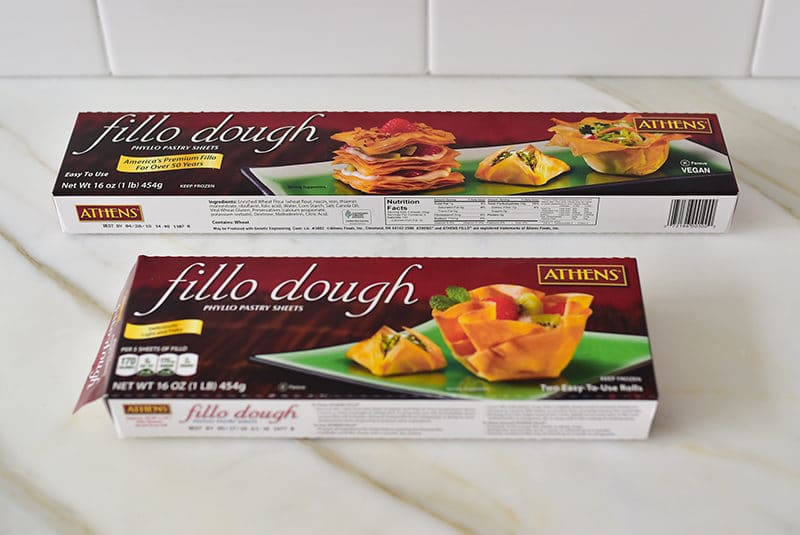
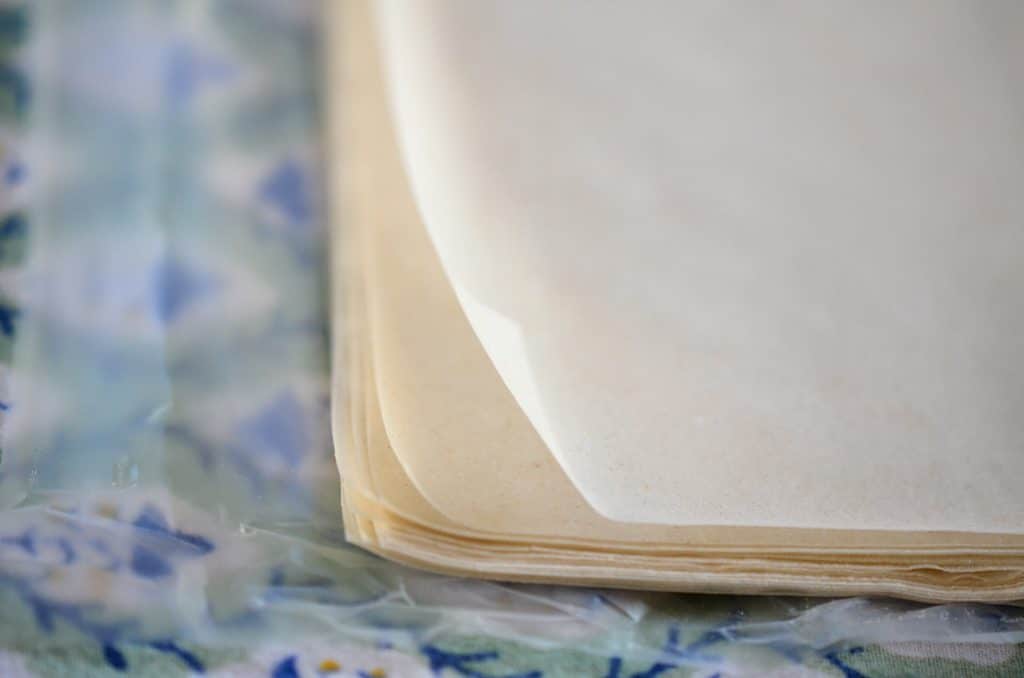
The simple syrup.
Lebanese baklawa is drenched in syrup flavored with flower water (not to be confused with flower extracts). Get pure Lebanese flower waters in my shop). Some recipes use a combination of rose and orange blossom water. I use orange blossom only, and I measure it away from the pan of syrup so I don’t make a mistake and over-pour into the syrup. Unlike vanilla extract, use this is a flavoring with restraint.
We often this “simple syrup,” even though actual simple syrup is simple because it’s a 1:1 ratio of sugar to water. Get a great recipe for Simple Syrup for baklawa, which has more sugar than water, but it’s still pretty darn simple. Take care not to cook the syrup too long. Use a timer just to be sure to nail it every time (5 minutes simmered after bringing to a boil). I like to double the recipe so that I always have syrup chilling in the refrigerator, just in case I want to whip up a batch of baklawa (yes, you can WHIP UP baklawa!).
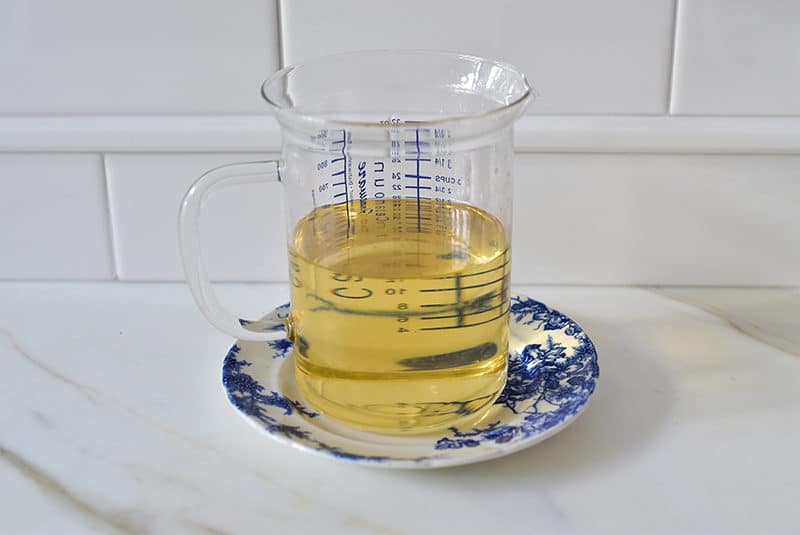
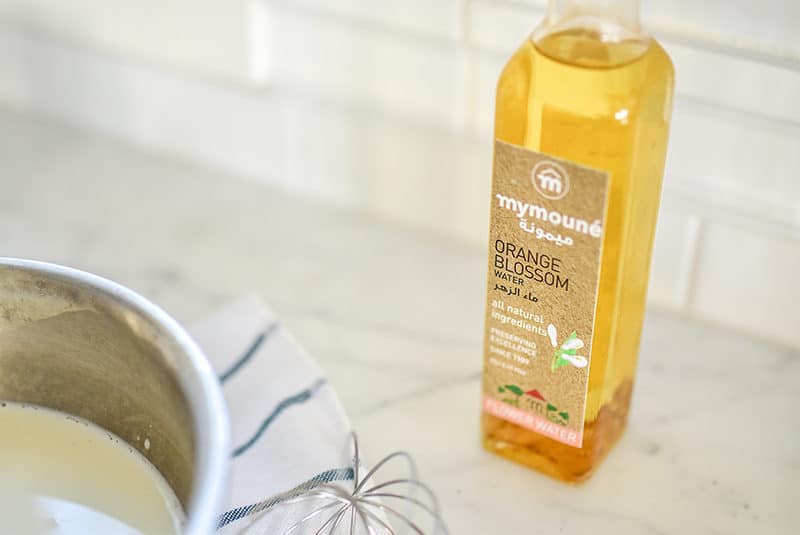
The Butter.
My cousin John Abowd (blood, real cuz!) made an off-hand comment once that the best baklawa he’d ever made was using local cultured butter in France. Well la-dee-da! And thank-you-John! I started using cultured butter for my baklawa after that and never looked back. This butter is richer, more flavorful, and more wonderful in every way. Salted or unsalted, either way is fine–I was strictly for unsalted butter, until one time when I had only salted butter on hand. Mom was there and said, “Honey, it will be delicious with salted butter.” She was (of course) right. Brands to look for: Plugra, Kerrygold, Land O Lakes European, or Organic Valley European.
Clarified butter is simply butterfat removed from the solids. The butter must be clarified because the solids will burn and look terrible on the baklawa. It’s golden and translucent.
Here is how to clarify butter with a thorough review of the methods to clarify. Lately, I’ve taken to melting at least one pound of butter on very low heat (there is always, always a container of clarified butter in my refrigerator). Use very low heat to avoid agitating the clarified butter and the solids, which clarifying is meant to separate. Most of the solids will settle on the bottom of the pan. There may be some foamy solids floating at the top. Remove these with a spoon, then pour off the clear butter, leaving the solids in the pan. Some of the clear butter has to stay behind so with the solids because it can’t all be poured away without getting solids mixed in at a certain point. Don’t feel wasteful; it’s okay. I figure it’s only about a teaspoon of clear butter anyway. Plus you can use it on vegetables, mmm.
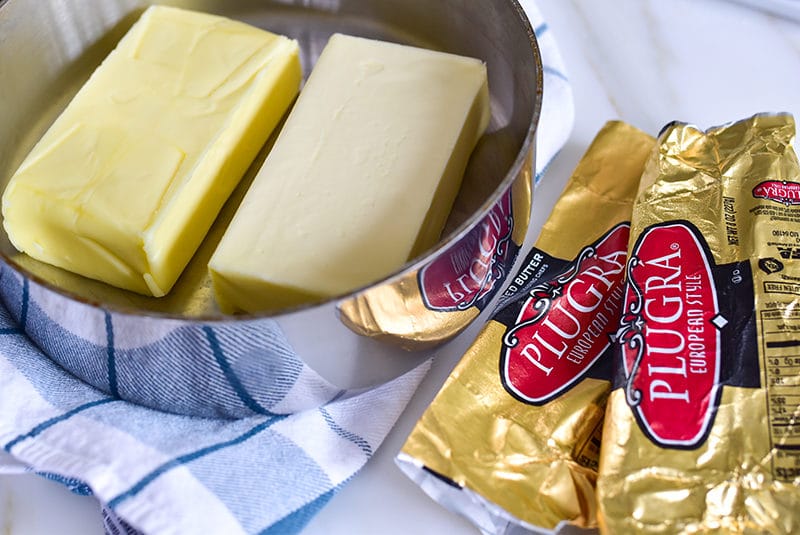
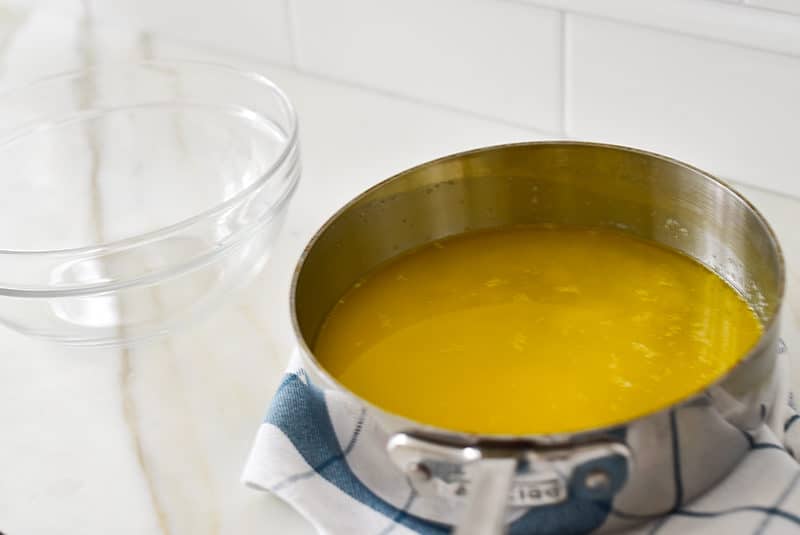
The Filling.
Use nuts of your favorite sort. My favorite is hands-down walnuts. But also: almonds, pistachios, cashews. Toast your nuts in advance, then it’s not “just another step” you’ll be tempted to skip in the moment of setting out to make baklawa. When you get your nuts home from the market, toast them for 10-12 minutes at 350°F. Cool and store in the freezer. You can even grind and sugar them in advance, and freeze.
Grinding the nuts has its nuances as well. The goal is not to end up with powdered nuts, or too much powder at all. The nuts should have plenty of little nuggets. This is easiest to achieve in a hand-grinder. Another cousin (aren’t I lucky?) sent me the grinder that our mothers and grandmothers preferred and that I prefer. A food processor works and I often use it but watch yourself, pace your pulses, and take care not to take the nuts too far, creating too much nut dust.
Measure the nuts before grinding. This is important for my baklawa recipe, so that there isn’t too much filling. I measured after grinding the day we made the baklawa video and wound up with too much in the middle. Good thing you couldn’t really tell….
A tidbit about the nuts that I picked up from Aunt Rita (among the many): don’t put flower water on the nuts. Makes them soggy, she said. Aunt Rita was after crunch; I am after crunch.
Any leftover sugared nuts go right into a Ziploc baggie in the freezer. To measure the already-ground nuts that are leftover, go scant by ½ cup for the diamonds recipe.
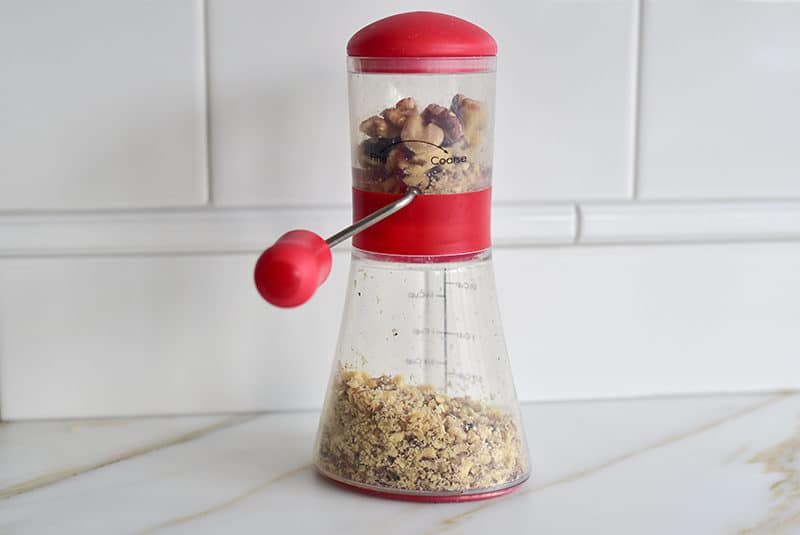
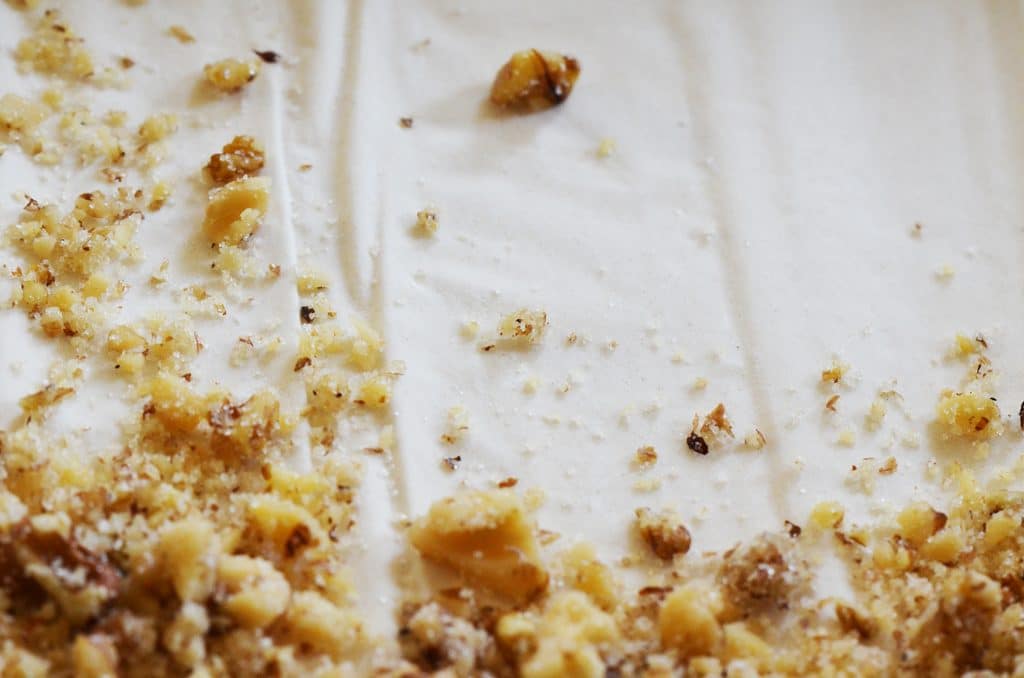
The Assembly.
Baklawa is fundamentally buttery layers of phyllo. How that butter reaches its destination is up for debate. That same Aunt Rita baked so much baklawa (she rendered 50 pounds of butter every Christmas. FIFTY!) that she came up with brilliant efficiencies. She put a stack of phyllo in the pan, then the nuts, then another stack. Cut, then pour her butter over all, letting it seep in. All I can say is: THIS WORKS! To make baklawa rolls, these layers have to be buttered individually before rolling them up, or else they’ll dry out and crack. So if you’re going to butter layers, make rolls. For diamonds, pour over.
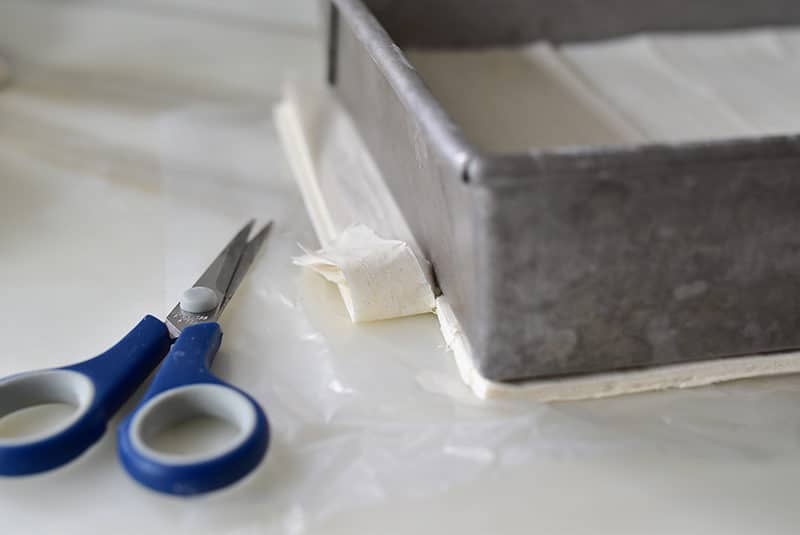
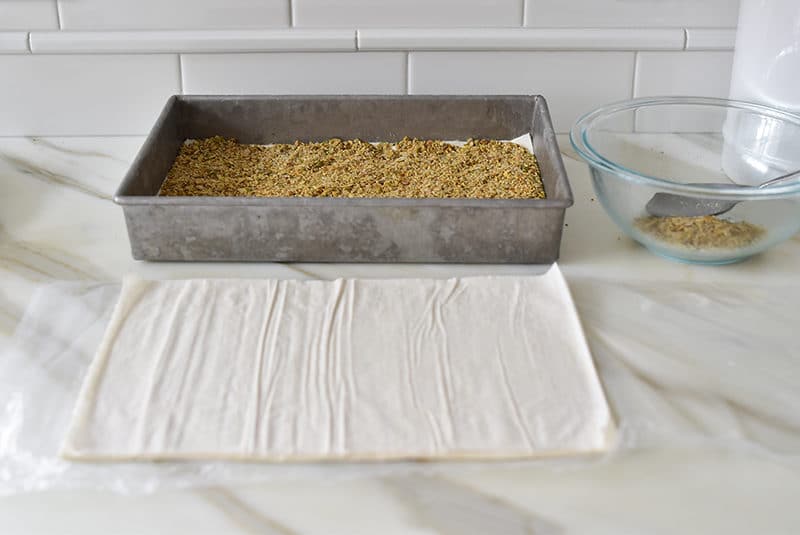
The Cutting.
Use a sharp chef’s knife. Now would be a good time to be sure your knives are sharp. I sharpen at least once a year. Aunt Louise uses an electric knife, and while I see that we have one that she must have given Dan years ago, I’ve never used it. I think it’s probably one of those innovations that makes a huge difference and once I do use it there won’t be any turning back. Til then, it’s a very sharp chef’s knife. Always cut the baklawa before baking, and cut through to the bottom of the pan, the same way you cut before baking my easy spanakopita recipe. Then, after baking and drenching in syrup, cut the pieces with a sharp knife to carefully remove from the pan.
Cut the diamond pattern. Using a 9x13x2-inch pan, mark and then cut five rows atop the phyllo stack. Then make nine cuts on the diagonal.
The number of columns you make will affect the size of each piece. When I want smaller pieces (and I do, often–they’re just easier to eat), then I cut six columns. Create the diamond pattern by cutting on the diagonal from the short size of the pan (at the top in the photo below) diagonally over to the long side. You go by feel on this as to how far apart to space these diagonal cuts. I line up the knife blade along the where I’m about to cut to see the diamond shape before I cut. Practice makes perfect….
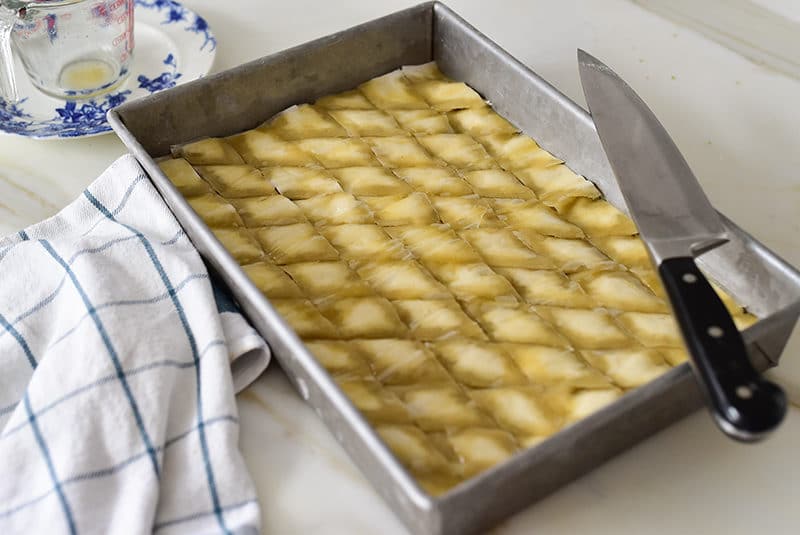
The Baking.
Again, room for debate. Shaheens bake it light and delicate with an end result that’s rather chewy. Aunt Hilda did same (because she learned from Louise Shaheen). Aboods go deep golden brown, with an end result that is crisp. Baklawa will lighten up in color in the days after it’s baked; this is not an illusion! Another reason besides great flavor and texture to bake it longer, no?! When the baklawa comes out of the oven, pour the cold syrup evenly over top, and listen up! The beautiful sizzle of the cold syrup sinking into the hot pastry is matched in your baking pleasure only by the incredible aroma of the baklawa.

Serving and storing baklava.
Keep the baklawa in the baking pan until serving time; it will keep in the baking pan for two weeks by my calendar, and a good month by Aunt Hilda’s. Cover the baklawa by lightly topping it with a piece of wax paper or parchment, leaving it loose on all sides and barely touching the top of the baklawa. This is really just to protect the top and not because the baklawa needs a covering. Once you cut the pieces from the pan, they begin to dry out. The cut baklawa pieces are best within a couple of days.
You can gift and serve the baklava by placing the pieces in little foil cups (foil mini-muffin cups, of which I have a near-lifetime supply from my sister-in-law Carol!). Use a sharp knife and follow the lines you’ve already cut.
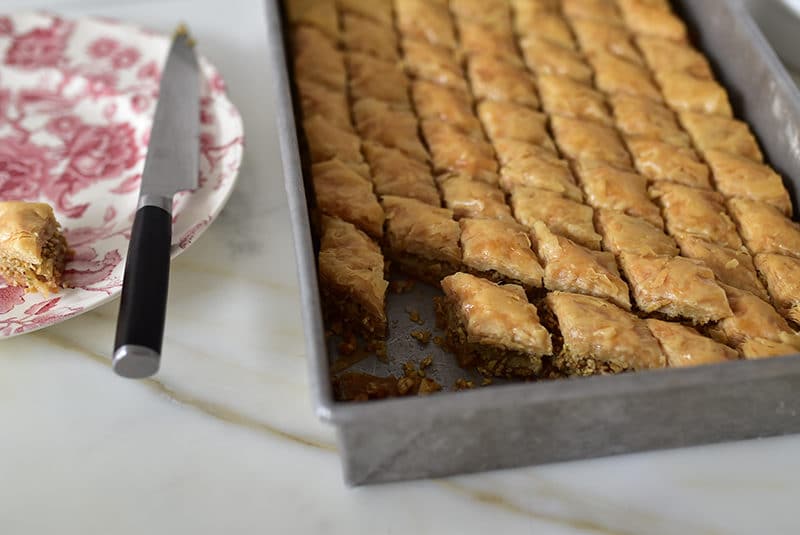
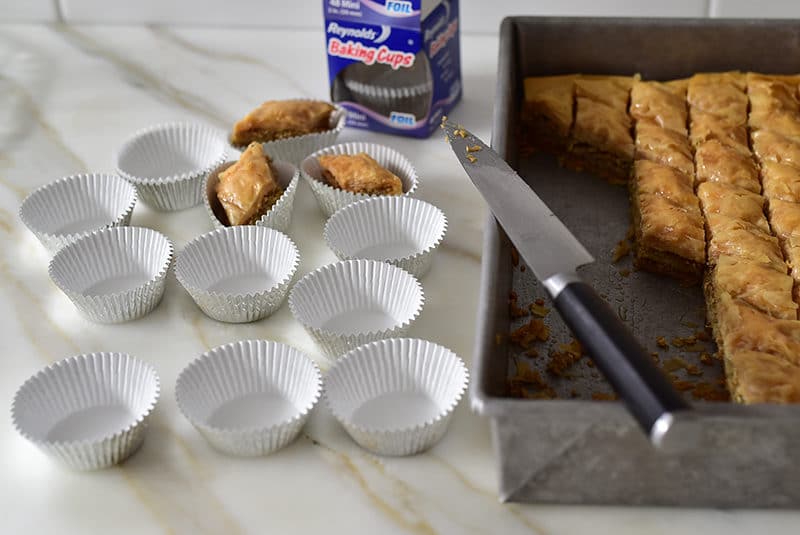
Lebanese Baklava Recipes:
You’ll find all of the recipes in my cookbook, Rose Water & Orange Blossoms: Fresh and Classic Recipes from my Lebanese Kitchen, and also here on my blog.
Watch my detailed how-to video here.
Here’s a quick look at how it’s done.
Here are several methods for How to clarify butter
Make your Simple Syrup with this easy recipe.
The Walnut Baklawa Diamonds recipe with Aunt Rita’s super-simple pour-over butter method is here.
Almond Baklawa Fingers are crisp little bites.
Nut-Free Baklawa makes the nut-free eaters so happy!
Try Olive Oil Baklawa with Pistachios for a butter-less version.
Pistachio Baklawa Nests are an Easter and spring favorite.
Here’s the woman I learned everything from . . . beautiful Mama!:
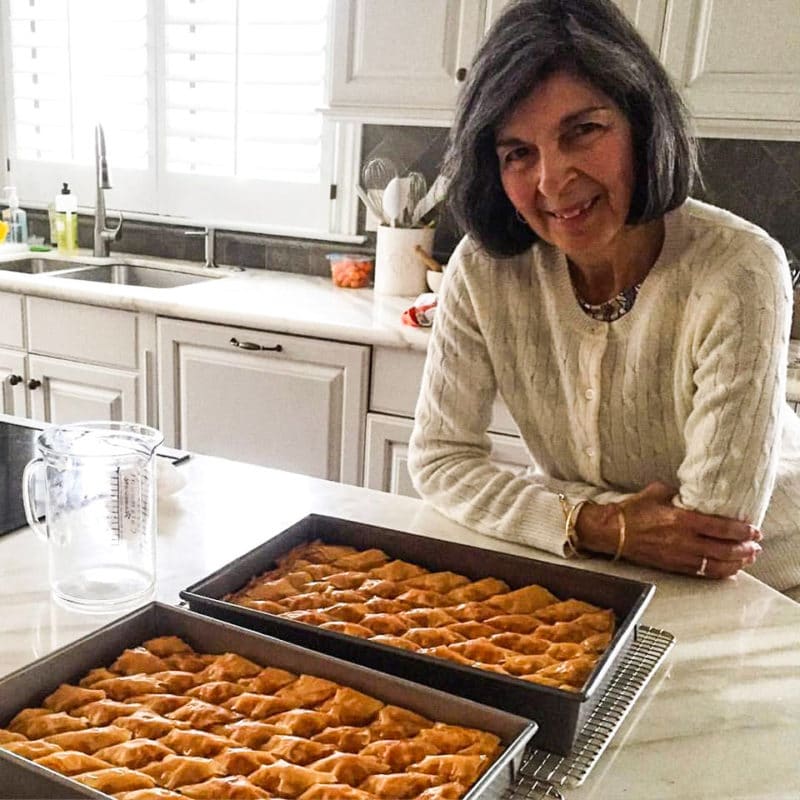
Share with me!
I’d love to know YOUR tips, tricks, and baklawa-baking secrets. I know you have them! Share here in the comments please and thank you!
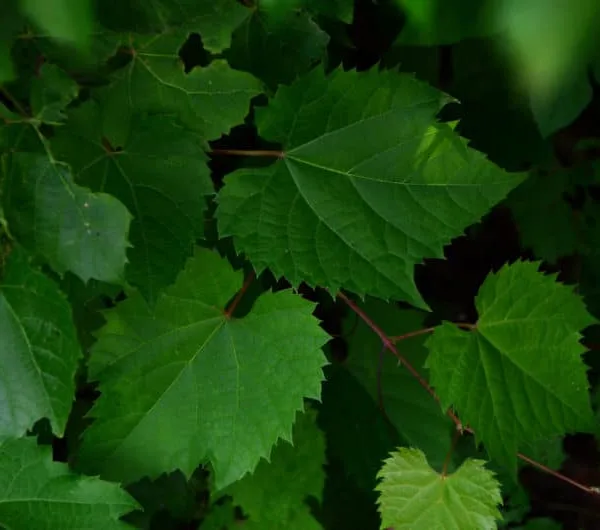
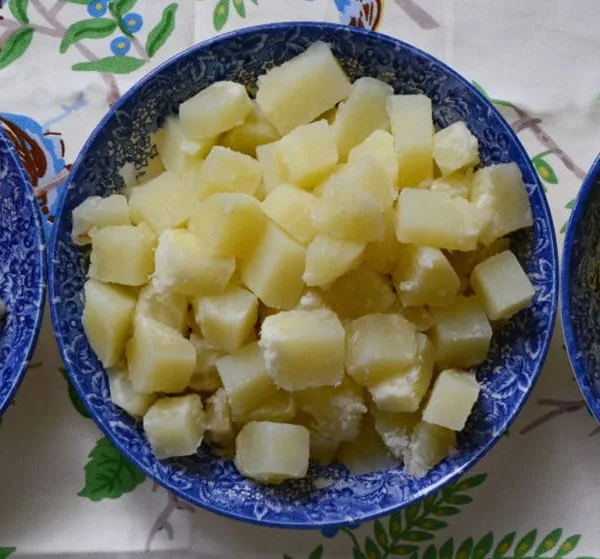
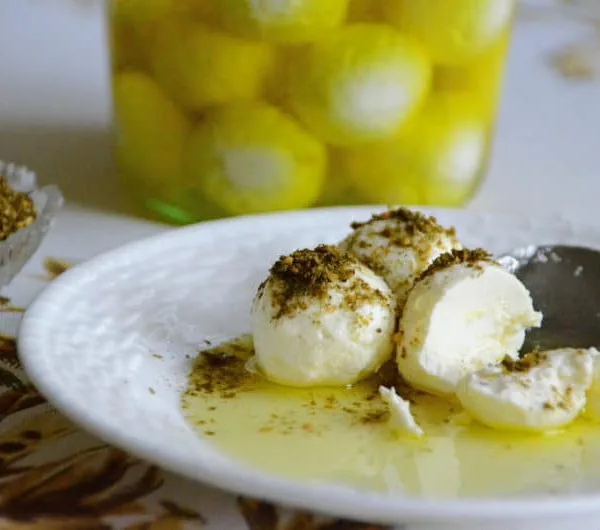
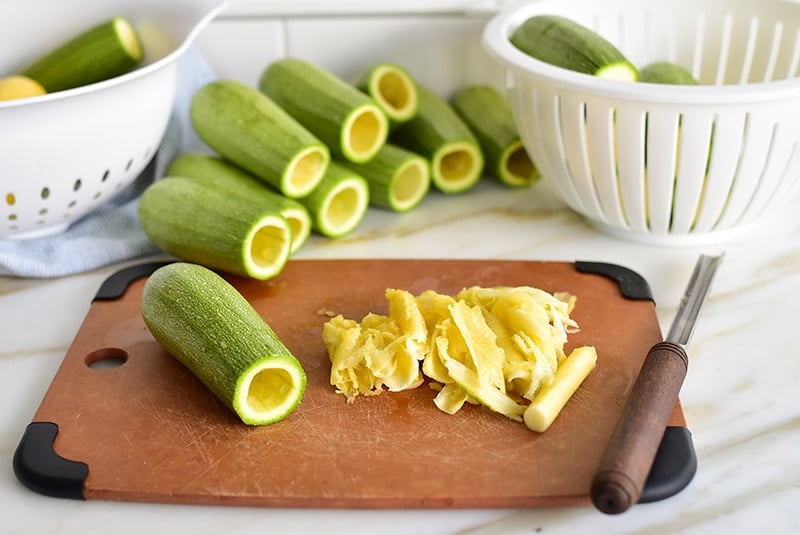







Hi Maureen! I’ve never before made baklava and I want to surprise my husband with it for Valentine’s Day. I want to use your recipe! I do have another easy looking recipe that calls for rose water and not orange water. What is your opinion on that?
Thank you!
Hi Judy! What a perfect Valentine treat. I much prefer orange blossom water to straight rose water. But if you would like to try with rose water, consider a mix of a teaspoon of orange blossom and a teaspoon of rose water in your syrup.
My local arabic store was out of a particular #4 brand I usually buy (Fillo Factory brand) so I bought Baraka brand, but on the box it does not say what # fillo dough it is. Do you happen to know? It seems they only have one kind where F.Factory has several (all variety of numbers)
Thanks for asking, it can be confusing. The brand I buy at my local grocery stores is Athens and there isn’t a number on them, it’s always the same and very thin which I like. I suspect the Baraka is the same, very thin if there isn’t a number on it.
I just made two trays for a neighbor. This method was so much faster. I also prepped the simple syrup and butter the night before. Just needed to chop the nuts. This method is a game changer. I told your cousin Rosemary I am now an orange blossom convert. So yummy.
Thanks!
Cindy thank you so very much for this! Cousin Rosemary is everyone’s rose! And orange blossom is just heavenly. I’m thrilled you are using my method and sounds like you are quite a baker. Please keep us posted on what you’re baking here! xxx
Hi Maureen, your recipes are so similar to what we grew up with… I’m so pleased!
Can you help me understand why the top layer of my baklawa is now getting all crumbly and curling while baking, rather than laying flat? I must be doing something different from the past but I can’t figure out what …. Heat, butter? Have you heard of spraying with water?
Thank you for any tips. My family loves my recipe but that top is not so pretty!
I’ve noticed curling lately too! I love your water-spray idea, which I’ll try. Sometimes I take that curled layer off after I pour the syrup over and I eat them all up (and the baklawa looks great!)!
My Grandmother’s recipe calls for preheat oven to 375 degrees; bake for 20 min; then reduce heat to 250 degrees for 1.5 hrs or longer to brown. I am always afraid to deviate!!
I like your tips; especially keeping the syrup cool..this I will try!
Thank you!
Hi Maureen! Love your site..
Have you ever baked Baklawa in a convection oven??
I am afraid to try. Reduce heat?? reduce time??
Been making my grandmothers recipe for over 30 yrs .. it is the best!!
Denine, great question. I don’t use convection for the baklava because I feel like I have more control on the browning if I take it slower with regular oven temps and no convection fan. That said, yes, reduce the heat for convection by 25 degrees; most ovens will automatically do that when you put it on convect. Then, reduce the baking time by checking at least 15 minutes before you normally would, to be sure you get the amount of browning you like. Keep us posted!
Hey Maureen. Not sure what happened this year, my nut filling is crumbling, falls apart. It tastes good but when I pick up a piece the filling crumbles out. Any ideas??
Janet that sometimes happens to me to. I wonder if you used too much filling? Measure from whole nuts before their chopped. Also are you waiting a good several hours before cutting the baklawa? That helps too.
How much sugar goes into the nuts after grinding
1/2 cup of granulated sugar with the ground nuts from 3 cups walnuts (measure before grinding).
Hi Maureen, I enjoyed reading your story and will try Aunt rita’s method. My mom (a Shaheen!) taught my 2 sisters and I how to make baklawa years ago (she typed up the instructions on an ancient typewriter) and every December we would go to her house and make dozens to give away to friends and family. We usually did a variation we called the Queen’s Sweet Bellybutton, a round spiral topped with nuts (but not a nest). My mom died at age 90 two years ago and my youngest sister just 2 months ago. Norma and I will carry on the family tradition. I found your blog originally in 2012 when I was making fatayar. This is the first time I’ve been back, but I will be a regular from now on. Merry Christmas and all best to you and yours.
Susan, this is so special, thank you–I’m happy to have you back! A Shaheen no less! That recipe is a treasure. I’d love to know more about the Queen’s Sweet Bellybutton. Do you have a photo/recipe/method?! Maybe you could email that to me if so!! maureen@maureenabood.com
Hello Maureen from Nova Scotia, Canada! I am of Lebanese descent and I just made baklawa for the first time, using your recipe and wonderful short cut. It turned out great! I used a glass pan because I don’t have a metal one of that size and I had no issues at all. My cuts were a little wonky but I expect that will improve with practice (lots and lots of yummy practice). Thank you for sharing your recipes and techniques!
Now if I could only get my yogurt-making mojo to work…(big fail, several times) 🙁
Sue, I’m so happy to hear this! You are READY for yogurt-making!
I’ve had baklawa from a Lebanese pastry shop that used a chocolate drizzle on the top. What kind of chocolate should I use?
Terry, delicious! Working with chocolate in this way can be tricky, in that if it is not tempered, the chocolate doesn’t set and will be soft and fudgy atop the baklawa. But the chocolate I’d use would be dark, 60% cacao. You can work from chips or chopped bars, melted. Learn more about tempering here.
Hi Maureen,
I am originally from Marjaouin, Lebanon and learned to make Baklawa from my mom…..she always buttered each layer up to 4-5 layers, put the nut mixture at one end , folded ends in and rolled securely, placing in an oblong baking pan…..put into fridge to cool and harden, then cut into about 2-3 inch pieces….baked with lots of tendered butter ….then poured prepared syrup on top and let set for several hours to absorb all the goodness….thank you for all your great tips!
Emily, I love hearing about how your mom made baklawa. Refrigerating is brilliant, just brilliant in helping make the cutting easier. I like the layering of nuts too and started doing that with my nut-free baklawa because the filling is made of tinier seeds. Thank you so much for sharing this!
Now, whenever I make Baklava, I always say thank you to your Aunt Rita and to you for sharing her ingenious method. It literally took ten minutes to put together (of course, I had the butter, nuts and syrup prepared ahead of time). It used to be very stressful, buttering every layer, making sure the Phyllo was covered and didn’t dry out, plus I think it turns out even better than before. Can’t thank you enough!
Bianca, what great affirmation! I’m so happy to hear it. I just made a batch this past weekend too with this method and it turned out beautifully!
I want to print the recipe for baklava using butter, not olive oil. I have spent a lot of time on the website looking for the recipe, but so far no luck. How do I find the PRINT for this recipe? Is there a flaw in the website?
Hi Virginia–find the recipe here and in the recipe you’ll see a green “print” button.
Hello Maureen, loving all your recipes! They’re the closest I’ve found to my favorite family recipes, so I just ordered 3 of your cookbooks. However, until they arrive, I would like to make your baklava. Could you direct me to a condensed recipe (shorter than the 44 pages online) to print?I may be missing it, but I have looked and cannot find a print icon.
Hi Nancy–try my baklawa recipe here–a great recipe! I have many others, with almonds, pistachios, nut-free, and vegan, all here on the blog.
Are You related to The Abood , that lived in Akron . There , Family in Detroit , I , think Marie and Walter Abood , and had 4 or 5 children. . They would Visit my Parents , they were In Akron. Wonderful Family . Thanks. Paul Salem . I make all Lebanese pastries , got the Recipe , from the Lebanese Friends .
Hello Paul! We may be related to that family but I don’t know them personally. But small world! I bet your pastries are divine. Very neat, keep in touch! Love to hear what you’re baking.
Hi Maureen,
Thank you for all these wonderful recipes! I love pistachios but have had trouble keeping them green in the baklawa (like they do in the Middle East). They are not as sturdy as the walnuts and over brown easily. Although, I have not been toasting them prior to baking, like you recommend for the walnuts, they still get brown. I am wondering if I should add orange blossom water to them although it was not recommended for the walnuts. What do you think?
Thanks!
Hi Reem! I hold off on adding the flower water to the nuts, just because I like them to be as toasty and crisp as possible and the flower water makes them softer. The flavor, though, is great; if you don’t mind the softer nut texture, you can absolutely add the orange blossom water to the pistachios. Keeping them green is not easy and I’m very interested in finding out how to achieve the very bright green we see in our pastries from the Middle East. I buy ground pistachios that are bright green also, and I don’t think they’re died. So more on this subject to come!
Maureen, is that 2 boxes TOTAL of filo dough or just 1. Thanks
Hi there–when you purchase the shorter phyllo sheets (9×14″), there are two sleeves in one box. My recipe is for this size, and you need one box only.
May I say , I love your writing! I was raised in the kitchen with my Sitty, mother, aunts , sisters and brother and your stories remind me of living at home with my mother. Question; I’d Like to serve hot baklawa Christmas Day, do you think it’s possible to prepare the baklawa Christmas Eve and bake Christmas Day?
Thanks so much Kathleen! I don’t think you’ll want to assemble the baklawa a day before baking it, because the phyllo dries out so fast. Even covered with butter, I’d be concerned holding off on baking. But, if you have all of your components ready (nuts toasted, chopped, sugared; syrup made and in the fridge; butter clarified and measured; phyllo thawed overnight in the fridge then room temp for a couple of hours), the assembly will be fast for baking and eating it hot on Christmas day. I’d let the baklawa rest a good 15 minutes before serving it so that it holds together when you cut it from the pan warm.
Thank you for the wonderful recipes! The pour over technique sounds interesting. Doesn’t make the nuts soggy? You also mention the recipe from your “(beautiful mama!):” but there is no recipe or link after the colon. Can you correct? Thanks.
Hi Laurice–good question. The pour-over doesn’t make the nuts soggy at all. They toast beautifully! And sorry that my syntax is confusing in that sentence about my mom…what I meant was, “here is the person (the “one”) I learned from,” rather than “here is the recipe I learned.”
Mouth watering arabic sweets
My sister and I gave your book to our siblings for Christmas. Big hit!! Thank you.
SO heartwarming for me to hear this, thank you!!!
Hi Maureen! Thank you for this time saving technique! I have been making baklawa my Sitto’s way since 1982. I’m going to try this…I’m scared. Lol
In a different note, one aspect that troubles me is using aluminum pans. With all the research related to aluminum and disease, I wish that we had another alternative. Could it be baked in glass? Are there stainless steel pans? Where do you buy your pans? Thank you for all of the wonderful stories and recipes you share!!!!!
Thanks so much Michele–I haven’t tried the baklawa in a glass pan, but I’d be curious to hear about it. The curved corners aren’t great but may be worth it to you to avoid aluminum. My straight-sided pan is aluminum-coated steel from Williams-Sonoma, “Traditionaltouch” collection.
Maureen, not that I want to give away family secrets but, after clarifying the butter we put it in a spray bottle and spray each sheet. Place newspapers on the table for easy clean up of any overspray.
This is much quicker than a pastry brush.
THIS IS REVOLUTIONARY!!!! I’ve told both my mom and mother-in-law and they were tickled to hear this innovation, as am I. Bless you for giving away the family secret!! I can’t wait to try it.
This is such a helpful post! I always stay away from preparing these sweets because of the amount of time it takes to make (also because I find myself finishing off a tray in no time at all!).
Maureen
Love the pour over tip! I find that Baklawa freezes well.
Can you share what types of pans you are using?
Merry Christmas!
Pat
Hi Pat–I like the traditionaltouch straight-sided 13x9x2 rectangular pan from Williams-Sonoma. Calphalon also makes a good straight-sided pan.
I’m with you – bake longer is better-but that pour it all on top after assemble- I can just see my TaTa rolling her eyes in disgust. The time I made it with her – everything was going at the same time butter clarifying, syrup boiling, phyllo drying out nuts toasting – I couldn’t move fast enough and by God EVERY phyllo sheet was individually buttered both bottom and top!
Whenever I read your recipes – my TaTa come back alive again – thank you for that!! Merry Christmas my friend.
Oh yes, I bet her kitchen was a total machine! That’s a gift to have had that experience. And no way she’d approve of our easy method…til she tasted it (but even then, skeptical!). Thank you Margaret and Merry Christmas to you and yours!
As I’m Greek, I use honey in my syrup. All kinds of different honey. Orange blossom from Florida is my favorite. I also place a whole clove in the center each diamond and lightly spritz with water before I bake. I now use your method of “layering”. So much easier!
Sounds so good! I like your water spritz idea Niki!
Why would I water spritz? Would that help keep my top layer from curling up so badly?
Your recipes are very similar to what I grew up with….. So happy to have found you.
Mary, thanks so much! Water spritz is a very interesting idea to keep that top layer from curling. I will be testing this out soon, thank you!
I was happy to see in your recipe how to clarify butter. I have to confess, I don’t do it. I’m sure if both of my Sitto’s were alive, they would be shocked. LOL I also mix light butter with regular butter. Everyone seems to love my baqlawa and they think it’s just butter. Next time I’m going to try the butter you have mentioned. Thank you.
Mary we shock the Sittos all of the time, I’m sure!! I find clarifying European-style butter on very low heat to be incredibly easy. The solids simply stay at the bottom of the pot and you can pour off the clarified liquid gold and leave the solids behind.